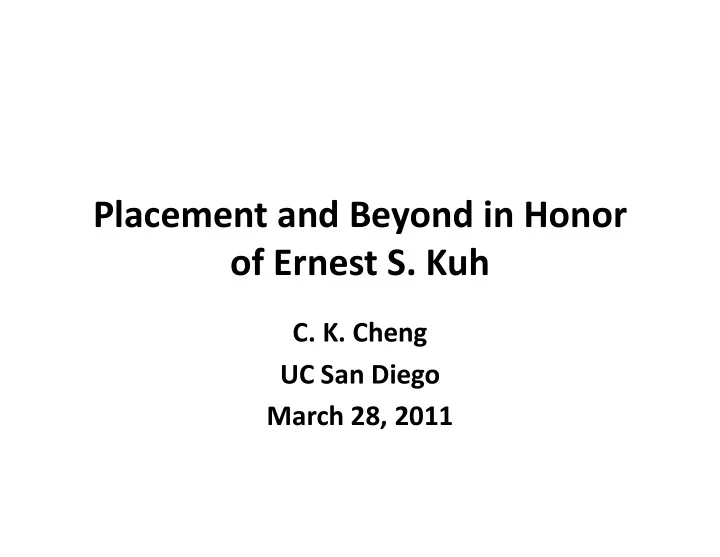

Placement and Beyond in Honor of Ernest S. Kuh C. K. Cheng UC San Diego UC San Diego March 28, 2011
Placement and Beyond Placement and Beyond • Ernest S. Kuh is a pioneer and giant in physical layout. • Board of Directors, Cadence Design Systems, San Jose, , g y , , Ca. (1984 ‐ 1991). • Chair, Scientific Advisory Committee, Cadence Design Systems (1988 ‐ 1991). S t (1988 1991) • C&C Prize, Japan Society for Promotion of Communication and Computers, 1996. Communication and Computers, 1996. • Phil Kaufman Award of the Electronic Design Automation Consortium, 1998. • EDAA Lifetime Achievement Award, 2008 • Robert Gustav Kirchhoff Award, 2009
Outlines • Placement Pl • Applications • Team • Second Waves • Second Waves • Scaling and Trends 3
Placement • 1 ‐ D Gate Assignment: Interval Graph • Building Block Layout: BBL, BEAR Building Block Layout: BBL, BEAR • Gate Array Layout: BAGEL • Standard Cell Placement: RAMP, PROUD • Performance Driven Placement: Performance Driven Placement: Congestion, Timing, Low Power 4 4
Placement • Productivity: Theory, Software Package, Application • Core of Physical Synthesis: > $500 Millions Market Core of Physical Synthesis: $500 Millions Market Logic Synthesis ESL Synthesis Placement DFT, DFM, ECO Timing Analysis Routing 5 5
Building Block Layout • Issues: Representation, Routability • Nonslicing Architecture – Representation: Tile Plane ep ese a o e a e – Routability: Routing Order for 100% routing completion ti l ti • Applications – Digital Equipment Corporation – ECAD Cadence ECAD, Cadence 6
Standard Cell Placement • Issues: Complexity, Timing Convergence due to Interconnect Dominance • RAMP, PROUD – Analogy of a resistive network Analogy of a resistive network – Quadratic wire length minimization • Analytical vs Iterative Approaches • Analytical vs. Iterative Approaches – Quadratic Programming – Simulated Annealing (‘83 Kirkpatrick) l d l (‘ k k) • Applications – Qplacer 7
Analytical Placement • Quinn and Breuer 1979: Force Model Quinn and Breuer, 1979: Force Model – Hook’s law for attraction – Repulsive force for pairs without connection • Antreich, Johannes, and Kirsh, 1982: Systematic Formulation • RAMP, 1983: Delete repulsive force – Sparse matrix operations Sparse matrix operations • GALA, 1984: Gate Array Layout, Hughes Aircraft Comp. • PROUD, 1988: Successive Over Relaxation • Qplacer, 1992: Louis Chao, Cadence • R.S. Tsay, 1992: Avanti, Synopsys • Eisenmann and Johannes 1998: • Eisenmann and Johannes, 1998: • Naylor, Donelly, Sha, 2001: Nonlinear function for hyperlinks, Synopsys 8
Application • 1983, Hughes: 104 seconds, 1 MIPs, 136 modules • 1991, Kleinhans et al.: 2500 seconds, 15 MIPs, 1991 Kl i h t l 2500 d 15 MIP 6417 modules • 1998, Eisenmann and Johannes: 2031 seconds, AlphaStation (266 MHz), 25K modules • Present: 6 ‐ 7M components of 30 ‐ 40 transistors 9
Teams • Building Block Layout: Nang ‐ Ping Chen, Chi ‐ Ping Hsu, Chao ‐ Chiang Chen, Wayne Dai, Bernhard Eschermann, Massoud Pedram, Yasushi Ogawa, and Margaret Sadowska • Channel ordering scheme for the layout: Wayne Dai and Tetsuo Channel ordering scheme for the layout: Wayne Dai and Tetsuo Asano • Gate array layout: Margaret Sadowska, Jeong ‐ Tyng Li and C.K. Cheng • Standard placement: C.K. Cheng, Ren ‐ Song Tsay St d d l t C K Ch R S T • Low power placement: Massoud Pedram • Timing driven placement: Shen Lin, Srinivasan Arvind, Michael g p , , Jackson, Henrik Esbensen, and Margaret Sadowska • IO assignment: Massoud Pedram, Narasimha Bhat, Kamal Chaudhary, Deborah Wang and Margaret Sadowska Deborah Wang, and Margaret Sadowska • Gate matrix layout: Dong ‐ Min Xu • Partitioning: Minshine Shih • Floorplan: Pinhong Chen, Hiroshi Murata 10
Second Waves • Prof. Hidoshi Onodera , Kyoto University: building block placement, 1991 p , • Prof. Xianlong Hong, Tsinghua University: floorplan representation, corner block list, 2000 p , , • Prof. John Lillis, University of Illinois, Chicago : placement tool, Mongrel using hybrid techniques for standard cell placement, 2000 • Prof. Andrew B. Kahng, UC San Diego: APlacer which won ACM International Symposium on Physical Design placement contest, 2005 11
Scaling and Trends Optimal Solution or Error Bound? • Steinberg, 1961: 34 modules • Stevens, 1972: 67 ‐ 151 modules S e e s, 9 6 5 odu es • Hughes, 1983: 300 ‐ 500 modules • MCNC, 1991: 15K modules 12
Scaling and Trends Geometry Handling, Combinatorial Algorithms Circuit Performance and Algorithms, Circuit Performance, and Advancement of Technologies • Mi ed mod le placement • Mixed module placement • Placement of heterogeneous circuits • Placement integrating behavior synthesis • 3 ‐ D Placement • Parallel Placement 13
Placement and Beyond • Basic Circuit Theory, 1969 – Charles A. Desoer and Ernest S. Kuh • SPICE, 1971 – Ronald A. Rohrer and Donald O. Pederson • SWEC, 1991: Recursive Convolution – Shen Lin and Margaret Sadowska • Transmission Line, 1999: Model Order Reduction T i i Li 1999 M d l O d R d i – Janet Wang and Qingjian Yu • Analysis and Synthesis of Transmission Lines 2005 • Analysis and Synthesis of Transmission Lines, 2005 ‐ 2009: Passive and Active Equalizer • Circuit Simulation, 2005 ‐ 2009: Parallel SPICE 14
THANK YOU THANK YOU 15
Recommend
More recommend